
* The United States Air Force (USAF) was hesitant to adopt the B-52, with the preliminary design program enduring a roller-coaster ride and the project nearly abandoned several times. However, Boeing persisted with the design, and the Air Force finally decided it was the weapon they wanted. After that uncertain start, the USAF ended up buying over twice as many B-52s as originally planned, in one of the most expensive military procurement programs in US history.
* Even before the end of World War II, the US Army Air Forces (USAAF) were looking forward to a next-generation strategic bomber to follow the huge Convair B-36, then in development. In late 1945, the USAAF began evaluating requirements for such a new bomber, and on 13 February 1946 the service issued a formal specification for it, specifying greater speed than the B-36 and an operational radius of 8,050 kilometers (5,000 miles).
That was a mighty big order. The Boeing company responded with a design with the company designation of "Model 462", which looked something like a scaled-up B-29 Superfortress with six Wright T35 Typhoon turboprop engines, providing 4,100 kW (5,500 SHP) each. The USAAF liked the idea, and on 5 June 1946 the service awarded Boeing a study contract for the machine, which was given the military designation "XB-52" not long after. The contract specified a full-scale mockup, but not a functioning prototype.
The first flight prototype of the XT35 engine was fitted to the nose of a Boeing B-17 Fortress bomber to begin flight tests in September 1947, but as far as the Model 462 was concerned, it had become irrelevant. The USAAF had decided the bomber design couldn't meet the range specifications, and canceled the contract in October 1946.
* With the cancellation of the Model 462, the design team for the project, led by Boeing Chief Engineer Ed Wells, went back to the drawing board and produced a set of "Model 464" concepts, which were at first basically scaled-down Model 462s with four turboprops, instead of six. The "464-16" was designed to carry a large bombload over relatively short range, while the "464-17" was designed to carry a small bombload over long range. The Air Force (as the USAAF became in 1947) was interested in the 464-17 concept but concluded that it still wasn't what was needed, since it didn't amount to much of an advance over the B-36.
Some Air Force brass wanted to kill the effort completely at this point, but the designers were allowed to explore improved concepts. By August 1947, they had gone through several more iterations, finally stabilizing for a while on the "Model 464-29", with a 20-degree swept wing, mounting four Pratt & Whitney (P&W) XT57 turboprops; landing gear consisting of four two-wheel assemblies in a row along the centerline; and defensive armament consisting solely of a tail turret.
The Model 464-29 didn't really answer the requirement, either. The Air Force was beginning to want better performance, and was also very interested in Northrop's flying wing bombers, which appeared to be the way of the future at the time. The XB-52 project edged back towards cancellation. Boeing's engineers kept up the momentum as best they could, coming up with yet another concept, the "Model 464-35". The Air Force's adoption of inflight refueling meant that the 464-35 didn't have to be as big as earlier design concepts. It also had more aggressively swept wings, but it retained the four big turboprop engines, though fitted with contra-rotating propellers.
* In the meantime, events put the XB-52 project on firmer ground. In June 1948, Soviet dictator Josef Stalin imposed a blockade on Berlin, bringing the Cold War on in earnest. The Air Force immediately brought the B-52 project back to the front burner, awarding a contract for a mock-up and two flying prototypes, with the first prototype to be ready by early 1951. Government funding began to ramp up.
A Boeing design team, including George Schairer, Vaughn Blumenthal, and Art Carlsen, went to Wright-Patterson Air Force Base in Ohio and presented the 464-35 design to the Air Force representative, Colonel Pete Warden, on Thursday, 21 October 1948. Warden replied that the USAF was no longer interested in turboprop propulsion since it couldn't provide adequate performance or reliability; the Air Force wanted a jet-powered aircraft.
That must have exasperated the Boeing team, since the company had proposed turbojet-powered versions of the bomber over the previous few months and been told bluntly to forget it by other senior Air Force officials. However, Warden had become a believer in and an advocate for turbojet propulsion, and had been encouraging Pratt & Whitney to develop an advanced turbojet engine, the JT3, which would become famous as the J57. Warden felt that the JT3 engine would be the powerplant of choice for the new bomber. The Boeing group quickly threw off any confusion caused by this about-face. After some brainstorming at the hotel, they called Warden on Friday morning and told him they would have a new proposal fitting his requirements by Monday morning.
The design team had brought with them a proposal for a medium bomber that would use four Westinghouse J-40 turbojets, and that seemed like a good starting point for updating the 464-35 design. The team was joined by Ed Wells, H.W. Withington, and Maynard Pennell. The group of engineers worked from their hotel room in Dayton to scale up the medium bomber proposal to twice size, with eight JT3 engines mounted in pairs on pylons, fitted under a 35 degree swept wing. The 35-page proposal for the "464-49" was ready for Colonel Warden by Monday morning, along with a balsa-wood model Wells had built from materials obtained from a Dayton hobby shop.
The Air Force was very interested in this proposal, and the design team continued to tweak it to come up with a definitive design concept, the "464-67", in November 1949. The company began construction of the two prototypes on that basis but the USAF continued to waffle, considering alternatives for the service's strategic bomber requirement, such as enhancing the Boeing B-47 Stratojet bomber, then in advanced development, into an improved version designated the "B-47Z"; and a jet-powered, swept-wing version of the B-36, the "Convair YB-60".
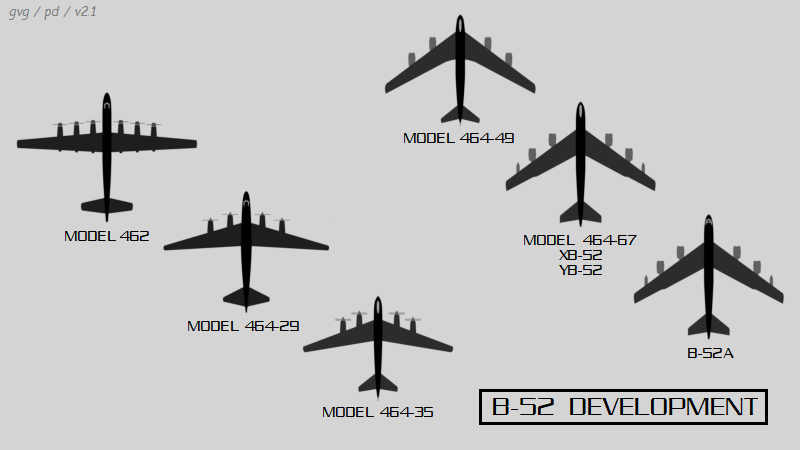
Fortunately for Boeing, General Curtis LeMay -- as of October 1948, commander of the Air Force's Strategic Air Command (SAC) -- remained enthusiastic about the XB-52. It still took over a year to get commitment to the Boeing machine, with Boeing finally awarded a contract for 13 "B-52As" on 14 February 1951. The program now shifted into high gear.
Even after this milestone, ambiguities lingered. USAF Headquarters decided that the service didn't have a need for a long-range bomber like the B-52 and wanted them all built as reconnaissance aircraft. SAC, in contrast, wanted to build the machine to operate both as a bomber and as a reconnaissance platform, with a reconnaissance pod plugged into the bomb bay for such missions. In October 1951, USAF HQ handed down an order that the new machines would be built as "RB-52" reconnaissance machines. On paper, SAC had lost; in practice, LeMay had got his way.
* Development of the two prototypes had gone forward in the meantime. The first prototype was given the designation "XB-52" and the second the designation "YB-52". The second prototype was given a "Y" code, which would normally indicate an evaluation machine -- not an "X" code as was appropriate to its experimental status -- because the Air Force had scrounged funding for it from their Logistics Command, which was not formally allowed to fund experimental aircraft.
The XB-52 was rolled out on 29 November 1951. The rollout was done late at night and with the aircraft bundled under tarps to help maintain secrecy. Unfortunately, the XB-52 suffered a catastrophic failure of its pneumatic system during ground testing that caused extensive damage to the trailing edge of the wing. It had to be sent it back inside the factory for lengthy repairs before it could perform a flight.
The YB-52 was rolled out on 15 March 1952 and actually performed the first flight on 15 April 1952, with Boeing test pilot A.M. "Tex" Johnson and Air Force Lieutenant Colonel Guy M. Townsend at the controls. The flight lasted a little under three hours, with take-off from Boeing Field in Seattle and landing at Moses Lake, east over the mountains in central Washington state. The flight went well, with a few minor technical problems as would be expected for such a big and complicated machine. Johnson complained that control forces were too high, making the machine tiring to fly, but they had been set high deliberately for whatever reasons, and so that was easy to fix. Other than that, Johnson reported that the YB-52 was "a hell of a good airplane."
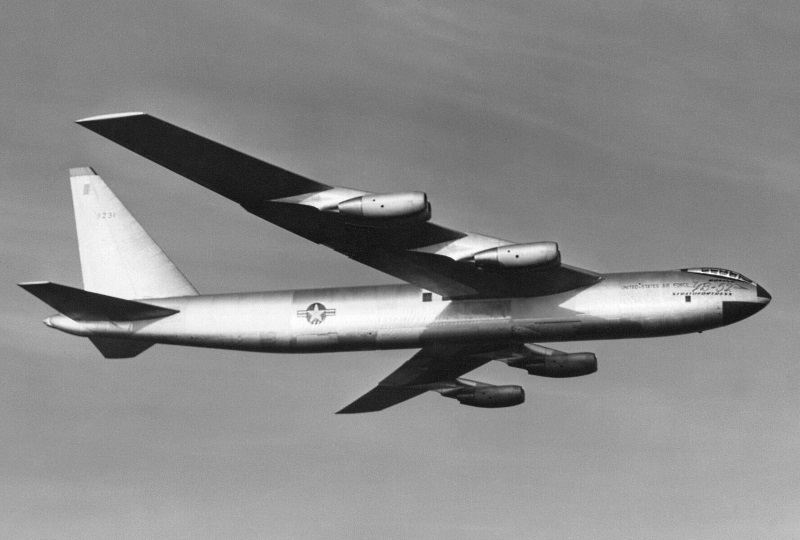
The flight trials went better than expected at first, the machine demonstrating no fundamental design flaws that would have dictated time-consuming major rework. Most of the test flights were initially from Boeing Field. Some factions in the Air Force wanted the tests to be conducted from Edwards Air Force Base (AFB) in California, since that was where the main USAF flight test center was based, and there was concern that notoriously damp Seattle weather would slow down testing.
Boeing protested that it would be easier to make fixes if the flight tests were conducted from the factory airfield, and that Seattle weather wasn't as bad as people made it out to be. In any case, the expense of moving the trials to Edwards kept it from happening, but in fact the weather did start to bog down the flight test schedule. As a result, the test flights were shifted to Moses Lake, in the sagebrush where rainy weather was generally not a problem, and then to Fairchild AFB, in Spokane, near the eastern border of the state.
The XB-52 joined the test program with its initial flight on 2 October 1952. By that time, the schedule had slipped a few months and the "new" machine was welcome. Some difficulties had cropped up, and the Air Force wanted them resolved so the bomber could be put into service. Problems included unfriendly flight characteristics when the machine was nearing a stall; inadequate brakes; and, in particular, poor reliability of the new J57 engines.
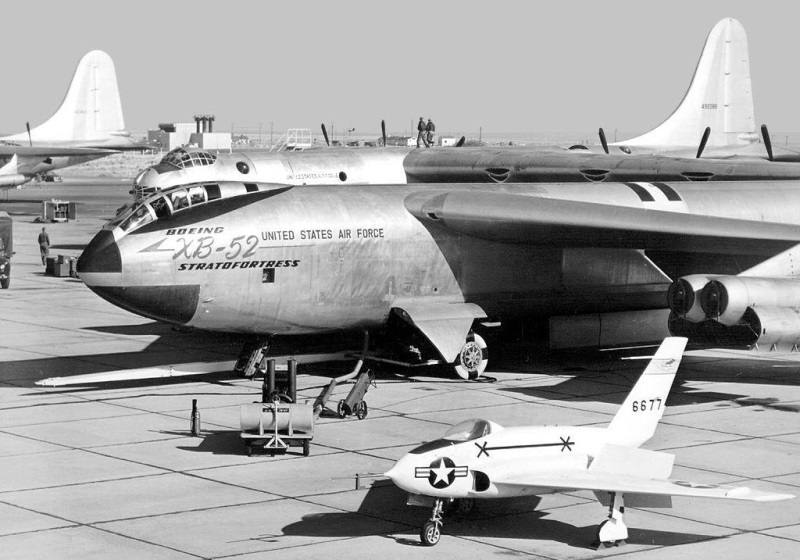
The XB-52 and YB-52 remained in use as test aircraft through the 1950s. The XB-52 was later modified with J75 engines replacing the outboard pods of two J57s, making it a six-engined aircraft. Although the YB-52 was donated on paper to the USAF Museum in Dayton, both aircraft ended up being scrapped during Lyndon Johnson's presidential administration, sometime in the mid-1960s.
BACK_TO_TOP* The XB-52 set the basic pattern for all that followed, though there would be many detail variations in later machines. It incorporated many concepts from the earlier Boeing B-47 bomber, but it was hardly a simple scale-up of the B-47 design.
The XB-52 was a big, boxy machine with a high-mounted wing swept back 35 degrees and a conventional tail arrangement. It was powered by eight P&W YJ57-3 engines providing 38.7 kN (3,950 kgp / 8,700 lbf) thrust each. The J57s were fitted in four pods, two engines to a pod, suspended on pylons below and forward of the wing. The inboard pods were 10.4 meters (34 feet 2 inches) from the centerline and the outboard pods were 18.29 meters (60 feet) from the centerline. Interestingly, in practice a pod suffering an uncontrollable fire would generally fall off the wing, sparing the rest of the aircraft, a "feature" Boeing engineers would later describe as an "unexpected benefit".
The wings were thick, with a chord to root section ratio of 15% at the root, tapering to 8% in the outer wing. They could flex from 3 meters (10 feet) down to 6.7 meters (22 feet) up. The heavy engines helped dampen wing flutter. There were two oversized "Fowler-type" flaps -- extending well behind the trailing edge of each wing -- with an aileron between the two flaps, plus a row of spoilers on top of the wing.
Sources are peculiarly inconsistent on the number of spoilers. Some sources claim that all variants had seven above each wing, but others claim that the XB-52 had three above each wing, while the YB-52 had six, this number being retained in all following B-52 versions except the last two, which had the magic seven. Whatever their number, the spoilers could be used asymmetrically to help the ailerons with roll control, or symmetrically to act as airbrakes, eliminating the need for a secondary "deceleration parachute" as used on the B-47. However, the aircraft still required a main drag parachute, 13.4 meters (44 feet) in diameter, stowed under the tail.
Most of the flight surfaces used manual control. The oversized tailfin was hinged so it could be folded down to allow the aircraft to fit into a hangar. The tailplane was of "all moving" configuration, with no elevators on the rear, and the entire tailplane adjusted for pitch control.
The wings and the fuselage were loaded up with flexible fuel bladders, providing a total capacity of 147,120 liters (38,820 US gallons). Bladders were used instead of integral fuel tanks to prevent leaks that would have been caused by the flexing of the airframe in flight. When fully fueled, the wingtips drooped 2.74 meters (nine feet) while sitting on the runway. They normally curved upward in flight. Fuel trim would be maintained manually by the copilot, following a set of procedures. No service B-52 would ever have an automatic fuel-trim system.
The landing gear scheme was unusual and elaborate, and in fact was kept secret during development. The main landing gear was organized in four big twin-wheel trucks mounted in the fuselage. The trucks were arranged in pairs, fore and aft of the bomb bay. Each truck in each pair opened under opposite sides of the fuselage, with the truck on the left retracting forward and that on the right retracting backward. The trucks rotated 90 degrees to lie flat in the fuselage when retracted. Each truck could be extended or retracted independently.
The trucks could be steered up to 20 degrees in either direction from the centerline, allowing the bomber to take-off or land at an angle in a crosswind. The steerable landing gear also helped during landings if an outboard engine failed. Some sources claim, plausibly, that the forward trucks could be turned 55 degrees off the centerline for taxiing. A small, stalky outrigger landing gear was fitted in the outboard section of each wing to prevent the wingtips from dragging the ground. Each outrigger retracted sideways into the wing, towards the fuselage. The outriggers would in principle permit a safe landing if only one truck in each pair could be extended. If the wing tanks had been drained, the outrigger wheels would usually not touch the ground on a landing.
As with the B-47, the landing gear arrangement prevented the bomber from performing a nose-up rotation during take-off. To deal with this issue, the B-47 had been designed to sit on the runway with a nose-up attitude. In contrast, the B-52's fuselage was kept level, while the wing was canted up six degrees instead. That meant that the machine could be climbing rapidly when the nose was still pointed down, an experience that probably felt something like riding in an elevator. One B-52 pilot commented: "You don't rotate at take-off speed ... it's more like you levitate."
System power was provided by a set of air turbines, protected by flak curtains and driven by engine bleed. The turbines provided power to electric generators, hydraulic pumps, the cabin pressurization and climate conditioning system, and other systems. Engine bleed was also used for de-icing the engine inlets, but the windscreen and other elements were de-iced by an electrical heating system.
The XB-52 and YB-52 used a twelve-pane "all-round vision" fighter-style canopy with pilot and copilot sitting in tandem. The canopy could be blown off to allow them to eject upward. Details of what other crew the two initial prototypes carried, in the space below the pilot and copilot, is unclear and was probably variable, depending on the flight-test phase.
The bomb bay was 8.5 meters long by 1.8 meters wide (28 by 6 feet), and had three sets of doors along its length. The doors could be folded up to improve access by armorers. A tail turret was planned as defensive armament, but the two prototypes were not armed, and in fact did not have full operational avionics. In service, B-52s would also be fitted with a belly camera for post-strike assessment, but it is unclear when this feature was implemented, and if it was implemented in all variants.
* The two initial prototypes were followed by three B-52A evaluation aircraft, the initial order for 13 having been changed, with the other 10 to be operational "B-52Bs". The first B-52A was rolled out from the Boeing Seattle plant on 18 March 1954 and made its initial flight on 5 August 1954. The other two were also rolled out from Boeing-Seattle in 1954.
The B-52As featured a new side-by-side cockpit scheme, eliminating the fighter-style canopy, and a tail turret fitted with four 12.7-millimeter (0.50-caliber) Browning M3 machine guns, with 600 rounds per gun. However, the B-52As were still not fitted with full operational avionics kit. The new cockpit had been planned since before the flight of the two prototypes. It had been adopted after Curtis LeMay inspected a mockup of the XB-52 and expressed his strong dislike of the tandem seating arrangement. A side-by-side seating arrangement, he argued, would provide greater space for instrument indicators, and permit better interaction between the pilot and copilot. No doubt, as with the B-47, the big tandem canopy was a real "hotbox" in bright sunlight.
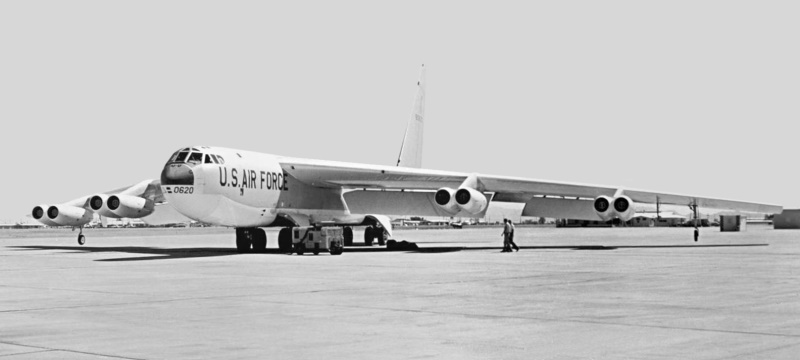
The pilot, copilot, and electronic warfare officer (EWO or "e-dub") sat in the upper flight deck, with upward-firing ejection seats, while the navigator and "radar navigator" (bombardier, more or less) sat in the lower flight deck, sometimes called the "black hole" or "hell hole", on downward-firing ejection seats. Access to the cockpit was through a door on the bottom. Despite the size of the aircraft, the crew accommodations were hardly roomy. The cockpit was pressurized, with the consequence that the forward section of every B-52 built quickly acquired a "wrinkled" appearance due to pressurization and depressurization. It gave the aircraft a somewhat weary appearance even when it was fairly new.
The tail gunner sat in the turret and could direct the guns with an A-3A fire control system (FCS). He could go forward through a non-pressurized crawlway over the bomb bay to join the rest of the crew if necessary. The tail gunner had no ejection seat, but the turret could be blown off the tail of the aircraft in an emergency to allow him to escape.
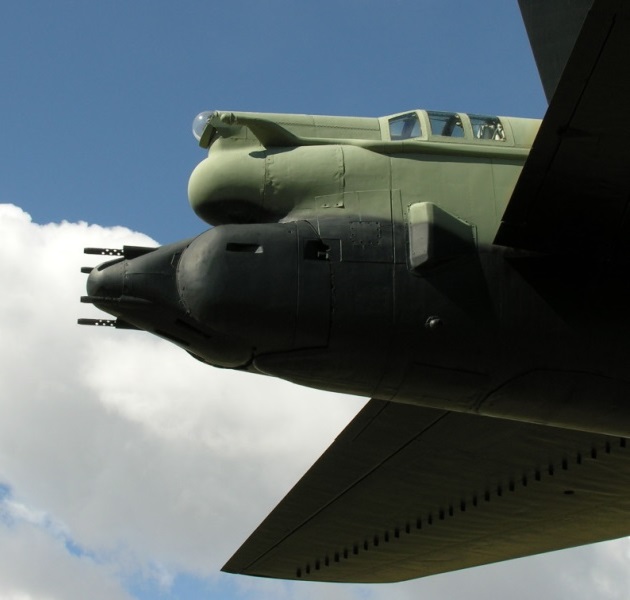
The B-52A was powered by P&W J57-9W engines, with 44.5 kN (4,535 kgp / 10,000 lbf) "dry" thrust each, or 49.0 kN (4,990 kgp / 11,000 lbf) "wet" thrust with water injection. Water injection added mass flow to boost thrust on take-off, and had not been available in the evaluation J57s used in the two prototypes. It provided a substantial kick, though the engines were thunderously noisy when it was engaged and poured out thick nasty black smoke. The water, which was mixed with methanol as anti-freeze, was stored in a tank near the aircraft's tail.
An auxiliary fuel tank with a capacity of 3,787 liters (1,000 US gallons) was attached near each wingtip. Unlike the two prototypes, the B-52As were fitted with a boom receptacle behind the cockpit for inflight refueling. The refueling receptacle was retained in all following models of the B-52.
The three B-52As remained in service for a long time as test and special purpose aircraft, with some of their roles mentioned later. One of them was scrapped in 1961, while at least one of the remaining two still survives as a static display.
* The B-52B was very similar to the B-52A, but had (more or less) operational systems. 50 were built, all by the Boeing Seattle plant. 27 of these were "RB-52s", mentioned earlier, with provision for the installation of a pressurized reconnaissance capsule in the bomb bay. Ironically, by that time, Air Force brass had finally made up their minds that the B-52 was a strategic bomber, and had lost interest in using the aircraft in the reconnaissance role.
The reason for the "more or less" qualifier above was because Boeing and the Air Force had serious troubles obtaining workable operational systems. The B-52 was supposed to use the MA-2 bombing-navigation system (BNS), but the MA-2 ran into troubles, and so early production B-52Bs were fitted with the K-3A BNS, used on the Convair B-36. However, the B-52 flew at a substantially higher altitude than the B-36 and the K-3A simply didn't have the range to work properly. The system's manufacturer, Philco, implemented some temporary fixes to boost radar power output, but later B-52B production featured a better solution in the form of the MA-6A BNS, an improved version of the K-3A.
The other major systems problem with the B-52B was the tail turret and its FCS. Nine of the first ten RB-52Bs were fitted with the "quad-fifty" tail turret and A-3A FCS of the B-52A, but this was not a satisfactory solution, As a result, 18 RB-52Bs and 16 B-52Bs were fitted with an entirely different tail turret, fitted with twin M24A-1 20-millimeter cannon and an MD-5 FCS. That didn't work out much better, so the last 7 B-52Bs reverted to the quad-fifty turret, with a supposedly "improved" version of the A-3A.
Most of the B-52Bs were fitted with J57-P-29W or similar J57-P-29WA engines, but the last five were fitted with J57-P-19W engines. All these J57s had the same thrust rating, with 46.7 kN (4,760 kgp / 10,500 lbf) "dry" thrust and 53.9 kN (5,490 kgp / 12,100 lbf) "wet" thrust, but the J57-P-19W had compressor blades made of titanium, not steel, making it somewhat lighter.
___________________________________________________________________
BOEING B-52B STRATOFORTRESS:
___________________________________________________________________
wingspan:
56.39 meters (185 feet)
wing area:
371.6 sq_meters (4,000 sq_feet)
length:
47.74 meters (156 feet 7 inches)
height:
14.73 meters (48 feet 4 inches)
empty weight:
74,412 kilograms (164,080 pounds)
combat weight:
123,356 kilograms (272,000 pounds)
MTO weight:
190,476 kilograms (420,000 pounds)
max speed with combat load at altitude:
1,010 KPH (628 MPH / 546 KT)
service ceiling:
14,420 meters (47,300 feet)
take-off length:
2,500 meters (8,200 feet)
operational radius:
5,758 kilometers (3,576 MI / 3,110 NMI)
___________________________________________________________________
The pressurized reconnaissance capsule for the RB-52s could be fitted into the bomb bay in about four hours. It had accommodations for two systems operators, who sat on downward-firing ejection seats, and could be configured with different suites of reconnaissance gear. Possible kit could consist of long-focal-length and panoramic cameras plus photoflash flares for imaging reconnaissance; mapping radar and electronic intelligence (ELINT) receivers for electronic reconnaissance; and atmospheric instruments for weather reconnaissance. However, although a batch of capsules was obtained, there is no evidence that they were ever put into service; they were stockpiled for a few years, and then scrapped.
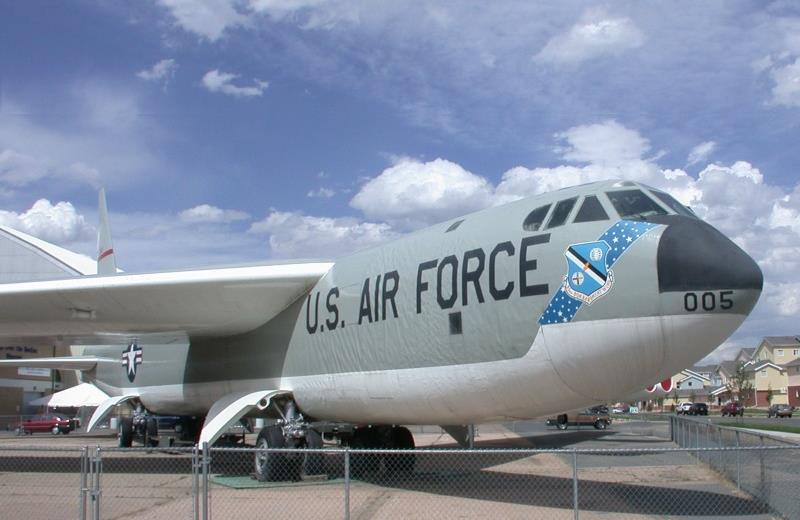
* An RB-52B was the first B-52 to go into formal operational service at Castle AFB, California, on 29 June 1955. Despite its complexity and size, the B-52 proved generally reliable in service, though the hydraulic systems and the air turbines did cause troubles that took time and effort to resolve. Most of the early B-52 variants also suffered from nagging fuel line leaks that would take several years and a number of update programs to get under control.
The aircraft was demanding, and only the most experienced crews were assigned to fly it. It also required that many airbases be upgraded with new runways, hangars, maintenance facilities, and so on to support the big bomber. In the late 1950s, the need to disperse B-52 operations to as many airfields as possible, including overseas installations, to protect them from a nuclear first strike led to a multiplication of this demand on resources.
On 21 May 1956, a B-52B flying from Eniwetok Island in the Pacific performed the first airdrop of a US hydrogen bomb in the CHEROKEE test, part of the REDWING series of nuclear shots. It was the first time the B-52 dropped a live nuclear bomb. The weapon, a Mark 15 "Zombie" with a yield of almost four megatons, was dropped over Bikini Atoll. Due to a procedural fungle the bomb detonated 30 seconds too soon, with the B-52 and other aircraft flying in the exercise caught up in the blast; they were badly beaten up but survived, which was fortunate since bailing out was not an option under the circumstances. B-52s would perform other test drops of nuclear weapons until 1963, when the US signed the Nuclear Test-Ban treaty, which prohibited above-ground testing to reduce releases of radioactive fallout into the environment.
Starting on 16 January 1957, three B-52Bs flew around the world nonstop under Project POWER FLITE, using mid-air refueling to stay aloft 45 hours and 19 minutes. The exercise was a clear demonstration of SAC's ability to reach any place in the world, just as the nuclear test drops demonstrated what the B-52 could do when it got there.
BACK_TO_TOP* The next variant, the "B-52C", was very similar to the B-52B, with the same J57 engine variants and generally similar avionics. The most visible difference from the B-52B was the fit of a huge 11,365-liter (3,000 US gallon) external tank under each wing. The water-injection tank in the rear fuselage was also removed, replaced by a water-injection tank in each wing root.
The B-52C was delivered in natural metal finish, with a coat of white paint on the underside to reflect the flash of a nuclear explosion. The "anti-flash white" underbelly would also be retroactively applied to the B-52Bs. In addition, B-52s were fitted with "flash curtains" that could be put over the windows to block out the glare of a nuclear fireball, though it is unclear when this feature was introduced into production.
The B-52C could carry a load of thermonuclear weapons or a total of 10,900 kilograms (24,000 pounds) of conventional bombs. Although most of the B-52Cs were fitted with the "improved" A-3A FCS used on late-production B-52Bs, it turned out to be not much of an improvement, and so the very last B-52C was fitted with the MD-9 FCS, which was finally a workable and effective piece of gear.
35 B-52Cs were delivered from Boeing-Seattle, making it the rarest of all production B-52s. They were all in principle compatible with the bomb bay reconnaissance capsule, though none of them formally received an "RB-52C" designation. Initial flight was on 9 March 1956, with delivery in June, and all B-52C production was completed in that year. In addition, seven B-52Bs were upgraded to something close to B-52C specification under the "Sunflower" program.
* The "B-52D" was nearly identical to the B-52C, with the MD-9 FCS as used on the last B-52C. The only significant difference was that the ability to carry the reconnaissance pod was deleted. 101 B-52Ds were built at Boeing-Seattle, while 69 more were made at Boeing-Wichita, the first B-52 model to be built at that plant. A Wichita-built B-52D was the first of that variant to fly, on 14 May 1956.
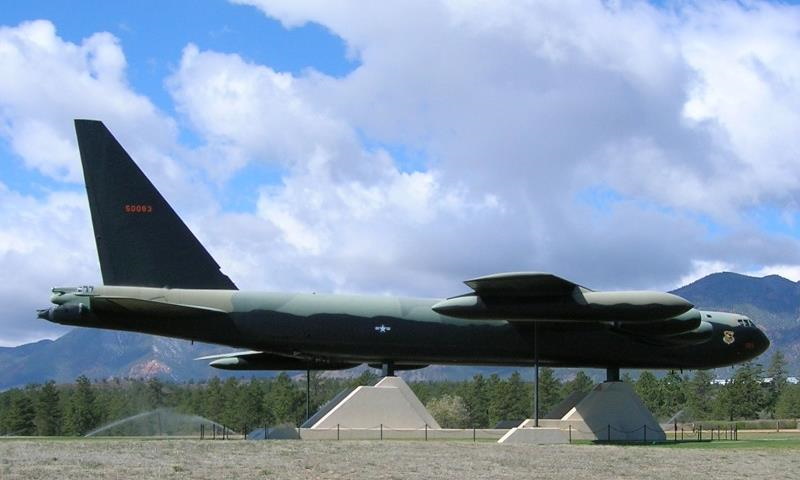
* The "B-52E" was externally similar to the B-52D, but featured improved internal systems. Soviet air defenses had improved to the point where high-altitude bombing was no longer practical, and so SAC switched to low-level tactics. The B-52E included new systems to support the low-level mission, most significantly an IBM-integrated AN/ASQ-38 navigation & bombing system, featuring Raytheon AN/ASB-4 navigation and bombing radar and a GPL AN/APN-89 Doppler groundspeed / height indicator.
The AN/ASQ-38 would be fitted to all following B-52 variants, but it didn't prove entirely satisfactory since it often failed to perform to specification in operation and was troublesome to maintain. An upgrade program named "Jolly Well" would be implemented across most of the B-52 fleet in the early 1960s to bring the AN/ASQ-38 up to a more satisfactory level of performance and maintainability. 42 B-52Es were built at Boeing-Seattle and 58 at Boeing-Wichita. First flight of a B-52E was on 17 October 1957.
* The "B-52F" was very similar to the B-52E, but featured new J57-43W engines, with 49.8 kN (5,080 kgp / 11,200 lbf) "dry" thrust and 61.2 kN (6,235 kgp / 13,750 lbf) "wet" thrust, in a revised pod configuration. Each pod had its own water-injection tank in the wing next to the pylon, and there were three inlets under the pod, two for oil coolers and one for a 40 kilowatt alternator. The alternator was powered by the left-hand engine in the pod through a Sundstrand drive in a blister on the left side of the pod. The alternator replaced the original and unreliable bleed-air turbines.
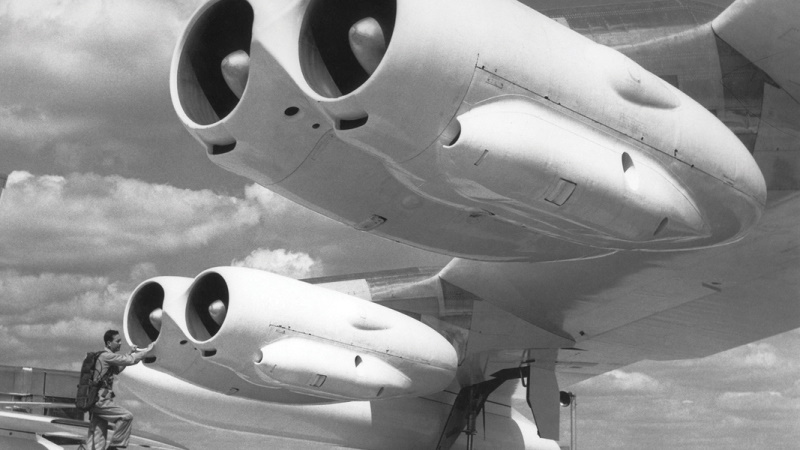
44 B-52Fs were built by Boeing-Seattle, the last B-52s to be delivered from that plant, and 45 were built by Boeing-Wichita. First flight of the B-52F was on 6 May 1958, with the last delivered in early 1959.
BACK_TO_TOP* The "B-52G" was the most heavily produced Stratofortress variant. It featured substantially increased internal fuel tankage. Having eliminated the hot piping for the bleed-air turbines in the B-52F allowed Boeing to rethink the wing fuel storage scheme, leading to fit of reliable integral tanks in the wing, replacing the fuel bladders. Integral fuel increased to 176,507 liters (46,572 US gallons) and the wingtip tanks were reduced to 2,650 liters (700 US gallons), for a total fuel capacity of 181,808 liters (47,970 US gallons).
The airframe had a number of improvements that reduced its empty weight by several tonnes, though as it turned out the redesigned wing would lead to troubles. The gunner was moved forward to sit with the rest of the flight crew, next to the EWO, and used an AN/ASG-15 FCS with a TV link to control the guns. The brake chute was moved from under the tail to the top, where the gunner's position had been in earlier versions. Moving the gunner forward would eventually prove to be something of a drawback, since aircrews appreciated having someone back in the tail to keep a lookout on the vulnerable "six" position.
The cockpit accommodations for the crew were significantly improved relative to earlier models, making long-duration flights less tiring. One of the important improvements was better climate control, since traditionally the upper deck crew tended to roast, while the lower deck crew froze.
The nose was lengthened a bit, while the height of the tailfin was cut by 2.44 meters (8 feet), making the B-52G instantly recognizable compared to early B-52 models. The short tailfin had been experimentally validated on one of the three B-52As; some sources claim this modified machine was redesignated the "XB-52G", though it was far from a full prototype of the B-52G.
If previous variants had six spoilers above each wing, as some sources claim, they were increased to the definitive seven in the B-52G, while the ailerons were eliminated, apparently to reduce weight. Roll control was now provided strictly by the spoilers. Pilots would find the lack of ailerons something of an inconvenience, particularly during midair refueling operations.
The B-52G was fitted with a pylon under each wing to carry a "GAM-77 (later AGM-28) Hound Dog" nuclear-armed turbojet-powered cruise missile. This capability was added with the 55th production B-52G and then retrofitted to early B-52Gs. The engines of the two Hound Dog could be used to provide additional thrust for the bomber on take-off, with the fuel for the missiles replenished from the B-52's own tanks in flight. The B-52G's cockpit also had a needle indicator controlled by the Hound Dog's guidance system. This was used to test the missile, essentially allowing the Hound Dog to "fly" the B-52 while still attached to the pylon.
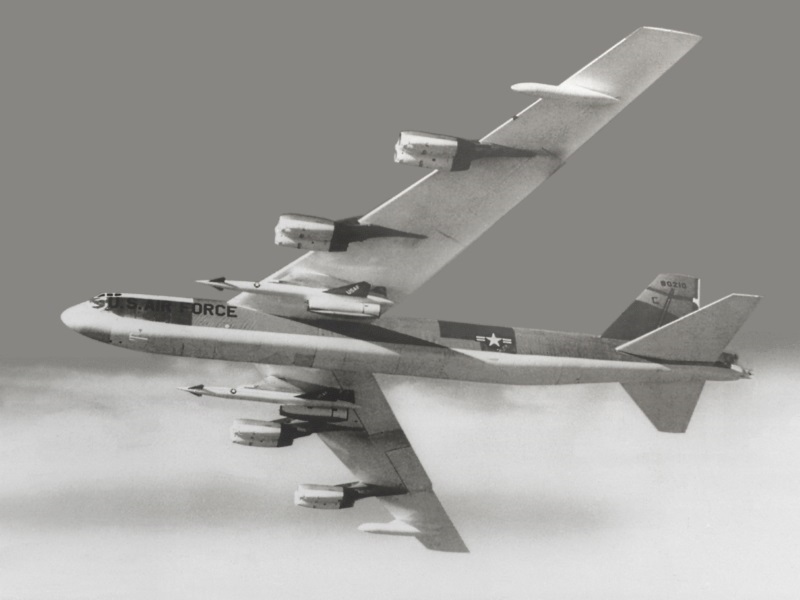
The Hound Dog, which was for some obscure reason apparently named for the Elvis Presley hit tune "You Ain't Nothin' But A Hound Dog", was developed to help deal with the Soviet Union's extensive and growing surface-to-air missile (SAM) network. It was not a very accurate weapon, but it had a big warhead and didn't need to be right on target. It had a maximum range of 1,300 kilometers (800 miles) on a high-altitude flight profile, though much less range at low altitude. Even its shortest range allowed a B-52 to stand off out of range of Soviet SAMs and obliterate their launch sites from a safe distance. That would open a "hole" in the defensive barrier to allow the bomber to enter and perform precision strikes on its targets.
The B-52G also stowed four ADM-20 "Quail" decoys in the bomb bay. The Quail was a little boxy robot aircraft that folded up neatly for stowage; it was lowered out of the bomb bay on a special rack to unfold its wings and then be released. Once in flight, it had performance and a radar cross-section similar to that of the B-52. It had a sophisticated guidance system by the standards of the time, allowing it to make two course changes and one speed change. It is unclear if any earlier versions of the B-52 were originally built with wing pylons -- but it is clear that the Hound Dog and Quail were eventually carried by many of the earlier B-52 variants.
All 193 B-52Gs were built at Boeing-Wichita, though Boeing-Seattle provided the forward fuselage. The first B-52G performed its initial flight on 31 August 1958, with deliveries beginning in that year and ending in 1961.
* The Air Force was expecting to field the North American B-70 Valkyrie supersonic bomber after the B-52, and so the B-52G was supposed to have been the final production model. In practice, only two XB-70s would be built, to be operated strictly as experimental machines. The USAF was also interested in obtaining the "GAM-87 Skybolt" air-launched ballistic missile, and so Boeing was given a contract to build the final B-52 variant, the "B-52H", as a Skybolt launch platform. The B-52H was to carry four Skybolts, with two on each underwing pylon. In fact, the Skybolt would be canceled in December 1962, and the B-52H would never carry it operationally. It would make do with the Hound Dog, and would also carry Quails.
Since SAC had moved to low-level tactics by that time, the B-52H was given structural reinforcements. It was also fitted with the P&W TF33-3 turbofan, a derivative of the J57, with 75.6 kN (7,710 kgp / 17,000 lbf) thrust. A B-52G had been temporarily fitted with these engines to validate their use for the B-52H, with some sources claiming this machine was redesignated the "YB-52H".
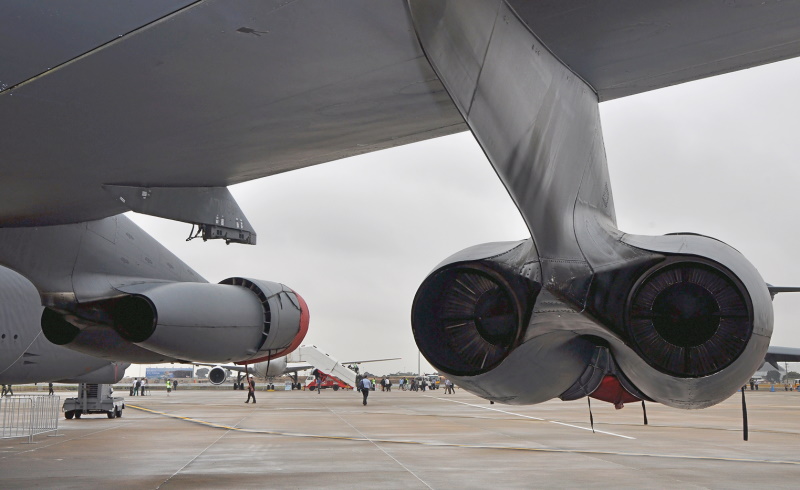
Although the new TF33s suffered from some flaws that would lead to a service update program in the early 1960s, they were otherwise a great improvement over the J57 all around. The TF33s eliminated the noisy and dirty water injection scheme of the J57 while providing much greater maximum thrust, and gave a smoother, quieter ride that made life easier for its crews. The TF33s were also much more fuel-efficient, which meant the B-52H had about 20% greater range than the B-52G. The Air Force demonstrated the increased range of the B-52H when, on 10:11 January 1962, one of them flew from Kadena AFB on Okinawa to Torrejon AFB in Spain nonstop, unrefueled, a distance of 20,177 kilometers (12,532 miles).
___________________________________________________________________
BOEING B-52H STRATOFORTRESS:
___________________________________________________________________
wingspan:
56.39 meters (185 feet)
wing area:
371.6 sq_meters (4,000 sq_feet)
length:
49.05 meters (160 feet 11 inches)
height:
12.40 meters (40 feet 8 inches)
empty weight:
78,340 kilograms (172,740 pounds)
combat weight:
138,940 kilograms (306,360 pounds)
MTO weight:
221,325 kilograms (488,000 pounds)
max speed with combat load at altitude:
1,012 KPH (629 MPH / 547 KT)
service ceiling:
14,540 meters (47,700 feet)
take-off length:
2,200 meters (7,420 feet)
operational radius:
7,730 kilometers (4,800 MI / 4,175 NMI)
___________________________________________________________________
The old quad-fifty turret was replaced by a new turret with a single 20-millimeter GE M61 Vulcan six-barreled Gatling-type cannon, directed by an Emerson ASG-21 fire control system. The cannon had a rate of fire of 6,000 rounds per minute and an ammunition supply of 1,242 rounds. The engine-driven alternators were also uprated to 120 kilowatts.
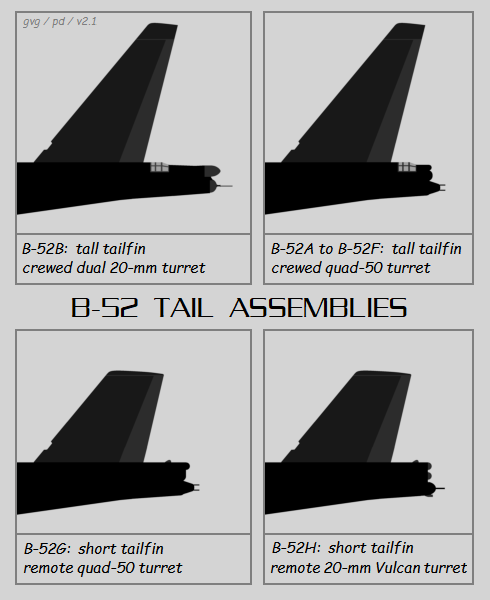
Late production B-52Hs featured a second stores pylon on each wing, positioned between the two engine pods. These short pylons were used to carry AN/ALE-25 chaff dispenser pods, which each contained twenty Tracor AN/ADR-8 6.35 centimeter (2.5 inch) folding-fin chaff rockets. The chaff rockets could be fired manually by the crew, or automatically by the bomber's defensive countermeasures system. The pylons were retrofitted to earlier B-52H production and to the B-52Gs.
* The first B-52H performed its initial flight on 6 March 1961. Boeing-Wichita built 102, with the last rolled out on 22 June 1962, after a total production of 744 B-52s of all types at a cost of $4.5 billion USD. At its peak, the B-52 equipped 42 SAC bomber squadrons, dispersed to 38 different airbases. Production included:
That gave a total of 744 B-52s, including prototypes, with 277 built in Seattle and 467 built in Wichita. Incidentally, back in 1953 the Air Force had contemplated obtaining a fleet of only 282 B-52s, but the number kept creeping upward during the decade as the service began to realize that the B-52 was not really the "interim" machine it had been expected to be. In fact, nobody would have ever guessed in their wildest dreams how long it would remain in service.
Although most of the B-52Hs were delivered with the same wing design as used on the B-52G, the last 18 were fitted with a modified and strengthened wing. The original B-52G wing turned out to be more prone to structural fatigue from the new low-level operations than the wings of earlier B-52 models. The weakness of the wing led to the crash of a B-52G near Goldsboro, North Carolina, on 24 January 1961, and implementation of temporary fight restrictions and a high-priority program to strengthen the wing. All earlier B-52Hs and all B-52Gs were refitted with the stronger wing in the 1962:1964 timeframe. The re-winging effort was conducted more or less in parallel with a more general program of structural reinforcements for most of the B-52 fleet under the designation "High Stress".
In addition, late production B-52Hs were fitted with improved avionics for the low-level role, including modifications to existing systems and addition of radar altimeters and terrain avoidance gear. These features were retrofitted to most earlier B-52s in operational service through the "Big Four" program, which was also performed in the early 1960s.
BACK_TO_TOP* A handful of the production B-52s were modified for special applications where an aircraft with heavy hauling and high-altitude capabilities was required.
The best-known of the special modifications were three B-52s used by the US National Aeronautics & Space Administration (NASA) to launch the X-15 experimental rocket "X-plane", the NASA lifting body experimental craft, Pegasus air-launched boosters, and other payloads. The first of the NASA B-52s was one of the three B-52As, which in the late 1950s was passed on to NASA and redesignated the "NB-52A"; NASA operated the aircraft, but the Air Force retained formal ownership. It was fitted with a strengthened right stores pylon to carry the X-15 and was operated by the NASA Dryden Center.
The NB-52A was retired in 1968 to the Pima Air & Space Museum in Tucson, Arizona, having been replaced by a similarly modified B-52B, which of course became the "NB-52B". It was one of the longest-flying B-52s; it was built in 1952, and was nicknamed "Balls-8" from its tail number, "008".
Since experimental flights are an occasional sort of thing, the NB-52B didn't burn up airframe time at any great rate, but by the end of the century it was extremely difficult to maintain since all its systems were obsolete, forcing Dryden engineers to scour boneyards and museums for spares, and on occasion even machining them from scratch. In 2001 NASA Dryden obtained a "new" B-52H, built in 1961, reconditioning and modifying it for the NASA drop mission. Balls-8 was retired in December 2004, to be displayed at Edwards Air Force Base.
The "new" B-52H, of course redesignated "NB-52H", featured an improved, strengthened pylon. It is set farther forward than the pylon on the NB-52B, which had to have its inboard flaps removed to accommodate drop payloads. The extended pylon on the NB-52H allows the flaps to be retained, reducing landing speed. Unlike its two predecessors, the NB-52H has been given a modern NASA gloss white-and-blue paint job, making it one of the best-dressed B-52s ever to fly. The Air Force intends to support the B-52H to 2040 or even beyond, and spares should not be as severe a problem.

* In the late 1960s, one or more B-52s were modified under the super-secret "Senior Bowl" program to carry and launch the "D-21" high-speed reconnaissance drone on modified Hound Dog pylons. The D-21 was a ramjet powered machine, intended primarily to perform reconnaissance of the Chinese nuclear center at Lop Nor, and was originally to be launched from the back of an "M-21", a modified Lockheed SR-71 Blackbird spyplane. However, launch separation of the D-21 from the M-21 proved troublesome, leading to the fatal crash of an M-21 in 1966.
The project was then redefined for B-52 launch, with the D-21 fitted to a big solid-fuel booster rocket to get it up to speed and altitude. A handful of D-21 launches were performed, including semi-operational missions over China, with dismal results. Given improved satellite reconnaissance and detente with China, the program was canceled in the early 1970s.
* One B-52E was used to test the GE XTF99 high-bypass ratio turbofan for the Lockheed C-5A Galaxy transport, with the big engine replacing one of the NB-52E's inboard engine pods. Initial flight of this machine, which was designated "NB-52E", with the XTF99 was 30 June 1968.
A second B-52E used for various test duties was also designated "NB-52E", and a B-52D used in a similar fashion was designated "NB-52D". A number of B-52s of differing variants were assigned to long-term duty as test machines and given the designation "JB-52", and some others were permanently grounded to be used for instructional duties, to be given the designation "GB-52".
BACK_TO_TOP